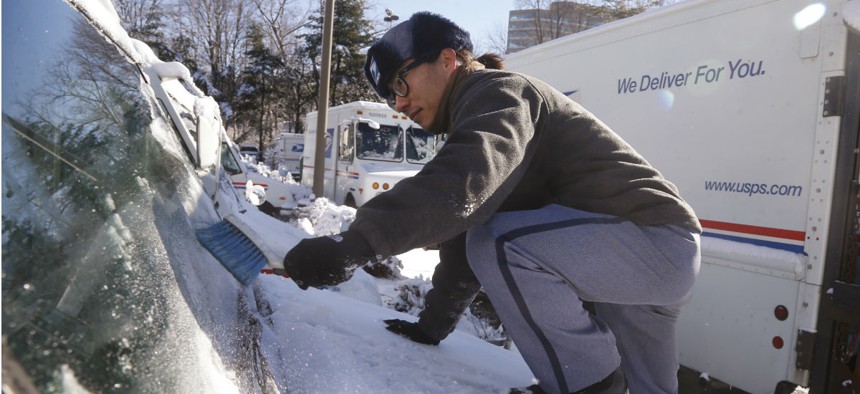
Announcement comes as the Postal Service is heading into its busy holiday season. Charles Dharapak/AP file photo
USPS Posts $5.1 Billion Net Loss in 2015 Despite Growing Revenue
Aside from costs incurred from unique congressional mandates, the Postal Service was operationally profitable.
The U.S. Postal Service turned an operational profit of $1.2 billion in fiscal 2015, marking the third consecutive year its revenue exceeded its controllable costs, though it continued to bleed into the red with a net loss of $5.1 billion due to external requirements from Congress.
While the agency actually grew revenue over the last year, USPS saw a net loss for the ninth consecutive year. The Postal Service pointed primarily to the congressionally mandated payments to fund future retirees’ health benefits as responsible for the loss. USPS failed to make a $5.7 billion payment into the prefunding account in fiscal 2015, after defaulting on similar payments the past two years.
Revenue jumped to $68.9 billion in fiscal 2015, which ended Sept. 30, a 1.6 percent increase over the previous year. Part of that growth stemmed from a temporary price hike that is scheduled to expire next spring, but revenue still grew year over year excluding gains from the surcharge. The controllable profit shrunk by $200 million from fiscal 2014, which postal officials attributed primarily to growing compensation costs.
Total mail volume dropped off by 1.3 billion pieces from fiscal 2014, though shipping and package volume continued its rapid growth. Volume in that sector grew 14 percent in fiscal 2015, while revenue has risen 50 percent over the last five years. First-class mail, USPS’ most profitable product, continued its precipitous decline with volume declining 2.2 percent. Standard mail, which many Americans colloquially refer to as “junk mail,” virtually stabilized last year.
As package revenue driven by e-commerce continues to make up a larger share of the Postal Service’s operations, profit margins have taken a hit, agency Chief Financial Officer Joe Corbett told reporters on a phone call Friday. The delivery of packages is more labor intensive than regular mail, he said, which will “exert pressure” on USPS’ finances.
Corbett cautioned that “growing revenue alone” is not enough to sustain the cash-strapped agency, which has for years asked for legislative action from Congress to allow an array of changes to postal operations. He noted the agency faces further “headwinds,” including next year’s expiration of the exigent price rate and the ongoing decline of first-class mail volume.
“We don’t have our heads in the sand,” Corbett said, saying the Postal Service is continuing to become leaner and more efficient.
Postmaster General Megan Brennan once again called on Congress to act, saying she wanted to build on two consecutive years of 10-figure controllable profits.
“To maintain this success we will need to continue our efforts to grow the business and drive operational efficiencies,” Brennan said. “However, we will also need the enactment of legislation that makes our retiree health benefit system affordable and that provides increased pricing and product flexibility.”
The National Association of Letter Carriers said the revenue growth and operational profits demonstrate that any cuts USPS would like to make through legislation are unnecessary.
“The USPS’ continuing financial upswing shows that dismantling services to the public would be precisely the wrong path to take,” NALC President Fredric Rolando said. “Today’s good news is consistent with -- and reinforces -- the growing momentum to move forward with constructive reform that all stakeholders can buy into.”
Brennan said, however, that USPS is working with various stakeholders to come up with legislation that both sides of the congressional aisle can approve. Sen. Tom Carper, D-Del., in September once again introduced a bill to overhaul the Postal Service, but the measure has yet to receive any attention in Congress. USPS has not outright rejected the bill, but has raised major concerns. Carper has said he is working with other lawmakers and stakeholders to promote and improve the bill.
In the meantime, the Postal Service is preparing for its busiest time of the year. USPS expects to deliver about 15 billion total pieces of mail this holiday season, Brennan said, and has hired 30,000 seasonal employees to assist with the increased workload. That figure is up from last holiday season, when the Postal Service took on about 21,000 temporary workers.







